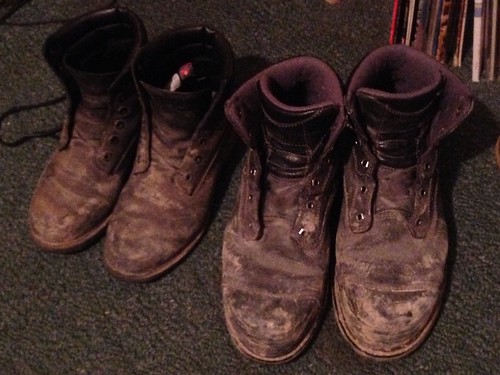Steel, composite, or alloy? A guide to work boot toes
When it comes to staying safe in the workplace, one of the most important things you can do is wear the proper protective gear. A good pair of work boots can prevent a lot of accidents that can cause pain and suffering and put you out of work. The main types of work boots come with steel, composite, or alloy toes. Which boots are best for you? Read our guide to learn more about each type and what they offer in terms of safety and comfort.
Potential Workplace Injuries

Wearing the proper type of boots can help protect your feet from a wide variety of work injuries. Some of the most common foot-related injuries are:
- Fractures.
- Sprains.
- Broken bones.
- Amputations.
- Cuts.
- Lacerations.
- Tears.
- Strains.
- Punctures.
- Chemical burns.
- Pain/soreness.
- Tarsal tunnel syndrome.
- Burns.
Protective boots are ideal for contractors, factory workers, construction workers, mechanics, welders, and anyone who operates or works around heavy or dangerous machinery. Most businesses that operate in dangerous industries require their employees to wear some form of protective boots to minimize the risk of severe injuries.
Additionally, all safety boots on the market need to meet safety standards set forth by the American Society for Testing and Materials, American National Standards Institute, and Occupational Safety and Health Administration. No matter which boot you choose, you’ll know that multiple organizations have rigorously tested them.
Composite-Toe Boots
Composite-toe boots are made of a combination of non-metal materials, such as plastic, fiberglass, and carbon fiber. These boots are not only lightweight and more comfortable than other types of work boots, but they are also highly durable. These are especially great for those who spend large amounts of time outdoors, like airport workers, construction workers, and utility workers, because they have insulation. Also, given that they do not contain metal, these boots are ideal for those who are frequently required to pass through metal detectors, such as those who work in security detail or at airports.
Here is a list of the pros and cons of composite-toe work boots:
Pros:
- They offer thermal insulation.
- They are metal-free.
- They are very lightweight and comfortable.
- They often come in more attractive designs than steel-toe boots.
- They are ideal for extreme weather conditions.
Cons:
- They are bulkier than other types of protective boots.
- They are not as sturdy as other types of work boots; they cannot withstand the level of impact of compression that alloy- and steel-toe boots can.
- They are usually more expensive than steel-toe boots.
Steel-Toe Boots
Steel-toe boots are tried and tested and have been around for over 80 years. They have been the go-to for those working in construction, manufacturing, and other fields that involve heavy machinery.
In terms of price point and protection, these boots have been the standard for those who are seeking high-quality boots that are also reasonably priced. With exceedingly high protection rates, these are the boots that people trust when they are working in dangerous sectors. Non-conductive materials, like rubber or leather, surround the steel toe, making it non-conductive. However, excessive wear and tear can expose the steel, causing a potential electrical hazard.
Here are the pros and cons of steel-toe boots:
Pros:
- They offer the strongest protection of all the work boots on the market.
- They offer maximum protection when using equipment such as chainsaws, hammers, grinders, and more.
- The toe area is thinner and less bulky than composite boots.
- They are typically reasonably priced and durable, so you don’t have to replace them often.
Cons:
- They are much heavier than composite boots.
- They are not nearly as comfortable as composite or alloy boots.
- They do not keep your feet warm in the winter.
- They set off metal detectors, making them inconvenient for those who work in high-security areas.
- They have a small toe box.
- They can be dented, causing the toe area to be cramped and uncomfortable.
Alloy-Toe Boots
Alloy-toe boots are made from materials such as aluminum, titanium, and a combination of other lightweight materials. They are a newer type of work boots that have recently become more popular because they are lighter and more comfortable than steel-toe boots. Like steel-toe boots, the alloy toe is protected by non-conductive materials, making them safe for electricians and similar professionals.
Here is a list of pros and cons of wearing alloy-toe boots:
Pros:
- They are thinner than steel-toe boots.
- They are up to 50% lighter than steel-toe boots.
- They offer more toe room than steel-toe boots.
Cons:
- They are more costly than steel-toe boots.
- They are not as protective as steel-toe boots.
- They set off metal detectors.
- They could potentially conduct electricity with excessive wear and tear.
Which Boots Should You Choose?
Wearing proper work boots can be one of the best methods of staying protected in the workplace. However, if you do not know which work boots are best for your position, you may be doing more harm than good. While each of these boots offers a high level of protection, they also have their downsides. For instance, steel-toe boots can be great for those who work in certain areas of construction or manufacturing, but they are not ideal for those who often work in extreme temperatures.
While composite-toe boots are great for jobs that involve moving around a lot and working in extreme temperatures, they are not ideal for dangerous jobs that involve heavy or sharp materials. Alloy-toe boots can provide a good level of protection for those who use heavy-duty equipment, but they will set off metal detectors. Though alloy-toe and steel-toe boots are non-conductive, any exposed metal in the toe poses a risk when working with electrical components.
No matter how much safety equipment you wear to work accidents still happen. Unsafe conditions can increase your risk of injury, potentially causing lingering health issues. If you need a work injury lawyer contact Lem Garcia Law for a free no-obligation consultation. Give us a call anytime day or night to discuss the details of your circumstance.


